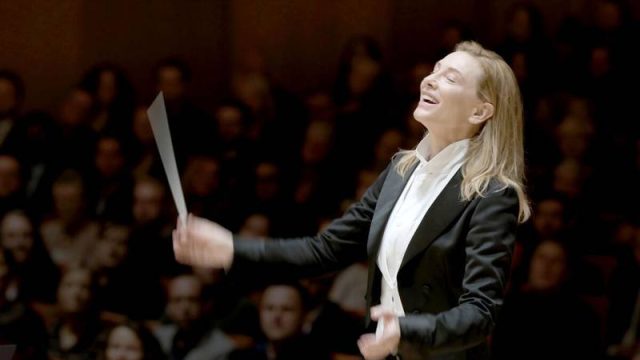Tár begins with celebrated conductor Lydia Tár in front of one crowd and ends with her in front of another. How Lydia finds herself in front of the second group and what the contrast in crowds says about art and its place in popular versus (quote-unquote) high culture has stirred the passions of online debate. But Tár is content to leave the Sturm und Drang to the conversations after the credits. It’s a strong character study and showcase of the massive talents of Cate Blanchette. It stirs the pot more successfully than the soul.
The movie, it’s said, is about “cancel culture.” But like most any sentence involving that phrase, it’s a reductive and inaccurate description. Blanchette’s maestro has many problems one of which, yes, involves backlash after surreptitiously recorded comments become public. The film bungles this aspect a bit, showing the controversial video as an obvious hack job and underestimating both online savvy about editing and the Internet’s likely ability to get rankled about Lydia’s undoctored remarks. There are hints of the watchful eye of social media, but Lydia seems as distant from that world as her symphonies from pop radio. But the distances are closing.
The fodder for that video comes from an electric scene, done in a single take that would make Alfonso Cuarón proud, where Lydia dresses down a queer BIPOC Julliard student in a conducting class when the student admits Bach’s status as a straight cis white man presents an insurmountable barrier. Lydia grasps the prerogative of the master to correct the student as she sees fit, but the conversation invites a more finessed touch than Lydia is interested in providing. This scene is just one instance of Lydia’s hubris, and the movie doesn’t trip the giant with one moment of indiscretion but the accumulation of years of unchecked power plays. Some slights are more minor than others but all have consequences and when the dominoes tip, the crash comes quicker than Lydia can react. She can no longer stay blind to the knowing looks from her wife (Nina Hoss) as Lydia spends extra time with her young assistants who, like the student vis-a-vis Bach, she has judged by standards not limited to musical ability. Her manipulation of the orchestra members earns her no supporters. Most ugly is an attempt to recast the relationship to a former student after her suicide.
Any of these problems would makes sense before the era of “cancellation”, and Lydia’s downfall has as much in common with Charles Foster Kane as any figure in current headlines. Best of all, Tár declines to take the kind of superior position Lydia relishes, with Field throwing out thorny details without worrying about the scoreboard. He depicts Lydia’s world as contradictorily cosmopolitan and hermetic. She bounces between a trendy but chilly family apartment and a more classical space reserved just for composing and practice, except when it’s constantly interrupted with doorbells and knocks. Lydia’s brushes with the world outside her bubble – a neighbor clearly out of her element, an anonymous scream in the woods – suggest the stakes of maintaining her perch above it all.
The film can get broad, like in a mercifully brief scene in the home of Lydia’s brother. And Field cuts to brief abstract interruptions as stress invades Lydia’s dreams. These produce one memorable moment (an unexpected flare up) but mostly they distract from the command Field and cinematographer Florian Hoffmeister display in ostentatious offices and in the darker, wetter corridors that Lydia encounters.
Just when this surprisingly swift movie starts to flag the final shot, timed like a punchline or maybe just a sucker punch, arrives just in time to pour out a new can of worms. But Tár knows the most difficult and surprising parts make for thrilling art, even if the same can ruin the artist.

